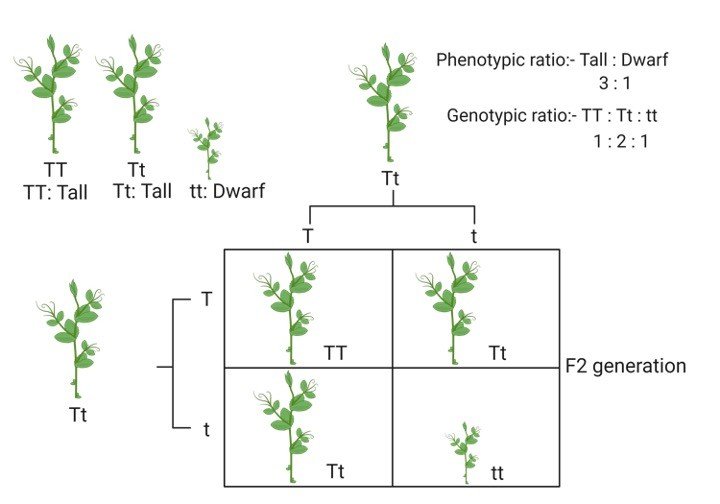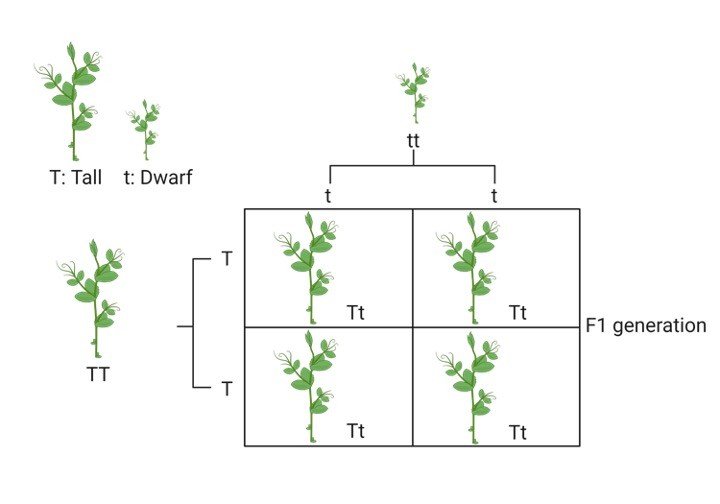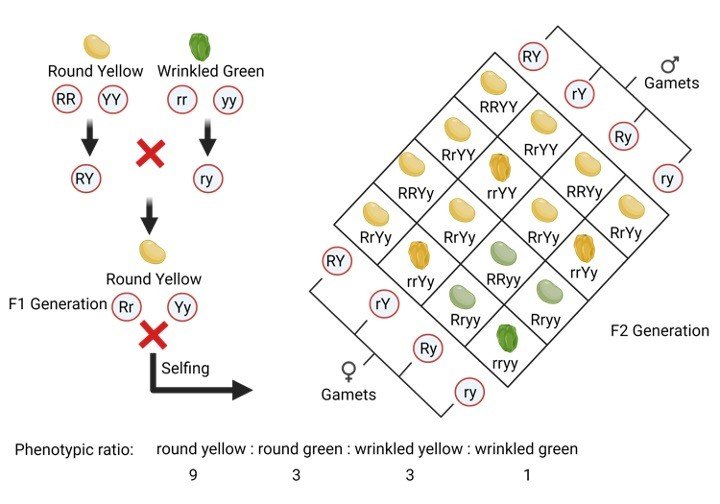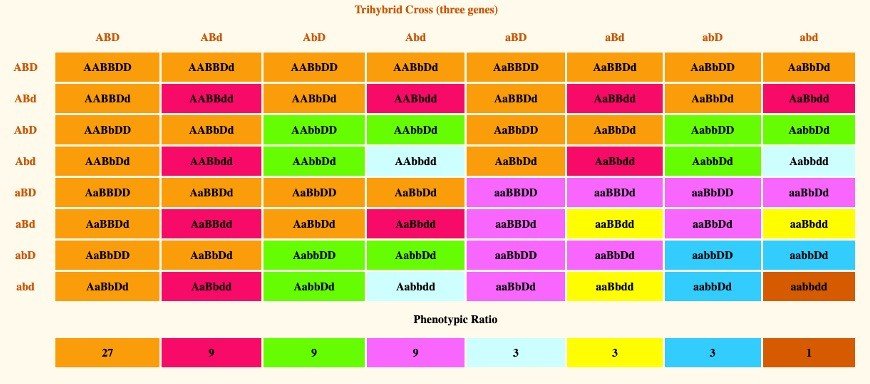Table of Contents
Phenotypic Ratio Definition
The phenotypic ratio is the relationship between the number of offspring who will inherit a certain characteristic or a set of traits. This ratio is often obtained by executing a test cross and then analysing the data from that cross to determine how frequently a trait or trait combination will be shown based on the genotype of the offspring.
What is Phenotypic Ratio?
A phenotypic ratio is a quantifiable relationship between phenotypes that shows how often the frequency of one phenotype corresponds with the frequency of another. The phenotypic ratio acquired from a test cross is used by researchers to get gene expression for generations of an organism.
A test cross is a genetics technique for investigating and obtaining the phenotypes and genotypes of organisms’ progeny. An organism’s genotype is its genetic make-up; it displays the alleles and genes that the organism possesses.
The phenotype is defined as the expression of genes and alleles in observable characteristics. Eye colour, height, and even hair texture are all phenotypes. Through a test cross, genotypes may be used to determine the phenotypes of an organism’s progeny and, as a result, the phenotypic ratio.
If a red insect and a blue bug mate, their progeny may be red, blue, or purple in colour (a mixture of both colours). To estimate the number of times a specific phenotype is observed in comparison to another phenotype, we’ll need to calculate the phenotypic ratio.
In layman’s words, phenotypic ratios can help us figure out if an insect is blue, red, or purple. The likelihood of an observable characteristic occurring in cross breeding. Punnett Squares or a phenotypic ratio calculator are the easiest ways to calculate phenotypic ratios.
Genetic Terminology
Before learning how to calculate a phenotypic ratio, you need to be familiar with the following genetic terms:
• Gene: A gene is anything that is inherited from a parent and handed on to their children.
• Allele: A gene variant that is passed down from one of two parents.
• The thread-like structure made up of nucleic acids and proteins that carries the gene is called a chromosome.
• A locus is the exact place on a chromosome where a gene is found.
• Heterozygous: a child who inherits two distinct alleles of the same gene.
• Homozygous: An offspring who inherits the same alleles from both parents for a certain gene.
• Even when it comes into touch with the recessive, the dominant allele will always be displayed as the phenotype.
• Recessive Allele: a gene that only expresses itself as a phenotype when it interacts with another recessive allele.
• Monohybrid: This occurs when two parents are crossed and just one phenotypic is produced.
• Dihybrid: When two parents are crossed, the children have phenotypes that are a mix of the parents’ traits.
• When two parents are crossed, the result is an offspring with a wider variety of traits than a dihybrid.
• Punnett Square: When certain parents are crossed, a square diagram is utilised to identify the genotype of children.
Phenotypic Ratio Calculation
We look at the alleles of the parent organisms and predict how often those genes will be expressed by the offspring to get a phenotypic ratio. We usually know what alleles will express and how they will appear. Punnett Squares or a phenotypic ratio calculator are the easiest ways to calculate phenotypic ratios.
| Trait | Frequency | Ranking | Phenotypic Ratio |
| Brown hair | 15 | 2 | 15 ÷ 5 = 3 |
| Black hair | 45 | 1 | 45 ÷ 5 = 9 |
| Red hair | 5 | 3 | 5 ÷ 5 = 1 |
Phenotypic Ratio Formula
To utilise the phenotypic ratio formula, you must first create a frequency chart, which you may do if you don’t have one already. Identify each desirable attribute and group them into columns. Then count the number of people who have particular features, making sure that each organism is only tallied once. From smallest to largest, the frequencies will be sorted. After that, each frequency will be divided by the least feasible frequency, and the result will be recorded in a separate column in the table.
The phenotypic ratio will be calculated using these responses, which will be rounded off. For example, in Table 1, the final phenotypic ratio is 9:3:1, with 9 representing black hair, 3 representing brown hair, and 1 representing red hair.
Phenotypic Ratio Calculation for Cross Type
A phenotypic ratio calculator created for specific crossings or a Punnett square can both be used. Calculations can be challenging in many cases, since phenotypes are exhibited when many alleles are mixed. The following instances, on the other hand, will use a single allele to generate a single characteristic.
We can get findings for phenotypes that will arise in the first filial generation (F1) of a crossover and subsequent generations using these calculating techniques. We can even predict the many consequences that may occur in later generations. Even without understanding everything there is to know about genetics, early horse and dog breeders knew how to produce animals with various characteristics. This sort of selective breeding has resulted in the enormous diversity of animal varieties that we have today. Some phenotypic ratios are straightforward.
What does it mean to have a 1:1 phenotypic ratio?
When organisms are crossed, there are only two phenotypic options that have a 50/50 probability of occurring, resulting in a 1:1 phenotypic ratio.
What does a phenotypic ratio of 3:1 imply?
This happens when two heterozygous parents each pass on one allele to their children, resulting in two potential phenotypes despite the presence of multiple genotypes. It’s crucial to keep in mind that genotypic and phenotypic ratios aren’t usually equal.

Phenotypic Ratio of Monohybrid Cross
A monohybrid cross occurs when two homozygous parents cross, resulting in just one trait in their offspring. It can also happen when both parents’ genotypes are entirely dominant or completely recessive, resulting in the opposite phenotype for some genetic characteristics. Using a Punnett Square, this may be easily established.


The genotype TT, has the phenotype of a tall tree, whereas the genotype, tt, has the phenotype of a short tree in this case. T is a dominant characteristic, which means that regardless of whether a recessive gene is present or not, the organism will always exhibit its phenotype. The gene is recessive, meaning it can only be seen when it is coupled with another allele of the same letter.
When they breed, each of the offspring will receive one of their alleles to make up their chromosome. Every offspring will be heterozygous since they must inherit one allele from each parent and the parents are both homozygous. Because their genotype is Tt, every offspring they create will grow to be a towering tree. As a result, the phenotypic ratio does not need to be calculated because all four offspring have the same phenotype. Because just one of the two potential outcomes (a tall or short tree) is an observable characteristic, calculating the phenotypic ratio would be superfluous. The phenotypic ratio would be expressed as 3:1 if it had to be shown.
Phenotypic Ratio of Dihybrid Cross
When two phenotypes are involved, dihybrid crossings come into play. However, there is a reason why breeders seldom use only one phenotype. If they do, they will never have the opportunity to investigate other options or build even more distinctive and interesting features. Why raise bigger pigs for more meat if they only get brain defects from both parents? As a result, geneticists continue to seek and promote beneficial breeds while avoiding breeding fewer desirable ones. They can calculate the phenotypic ratio using a dihybrid cross calculator.

The dihybrid cross between two yellow peas in the F1 Generation is shown in above figure. This cross’s preceding or parent generation consisted of two homozygous parents, one dominant (RR YY) and the other recessive (RR YY) (rr yy). The dominating RR had spherical peas and the colour YY, which was yellow. Wrinkled peas and a yy, green coloration was seen in recessive rr.
A yellow, round pea (RRYY) is crossed with a green, wrinkled pea in the parent crossing (rryy). As a result, all of their progeny are spherical and yellow, resulting in a monohybrid crossing. They are, however, heterozygous for the genes that produce yellow, green, round, or wrinkle alleles (RrYy).
When two RrYy children are crossed, they generate phenotypes that are distinct. They have round (R) and wrinkled (r) alleles, as well as yellow (Y) and green (G) alleles (y).
The use of a Punnett square to identify the offspring’s phenotypes is straightforward and provides a clear picture. The dihybrid Punnett square calculator makes determining the phenotypic ratio simple. Figure demonstrates how simply the genotype frequencies may be counted, yielding a 9:3:3:1 ratio for this hybrid. This may be applied to a wide range of phenotypes.
Phenotypic Ratio of Trihybrid Cross
When a second allele is introduced, the genetic expression and phenotypic possibilities grow even further. The phenotypic ratio for breeds like this one would be calculated using a trihybrid cross calculator. Because of the many different results that may be obtained from trihybrid cross ratios, they can be rather lengthy. Take, for example, the following scenario:
Humans are renowned for having a variety of hair kinds. Geneticists want to explore what happens if they mix individuals with different hair lengths, colours, and textures in one experiment. The dominant A allele results in long hair, whereas the recessive A allele results in short hair. The gene is shown as a dominant B in black hair and as a recessive B in brown hair. Finally, straight hair will be represented by a D and will be the dominant allele, while curly hair will be represented by a d and will be the recessive allele.

The researchers started with a monohybrid hair length phenotypic cross. They use two heterozygous parents to cross one gene. As previously stated in this article, this results in a 3:1 phenotypic ratio, generating both long and short-haired offspring. Despite the fact that some kids have long hair, they inherit the recessive gene for short hair. Long-haired children have a considerably larger chance of having long hair than short-haired offspring.
A second cross was performed, this time incorporating the hair colour gene. Because the two genes now give way to numerous phenotypic outputs, this dihybrid cross will produce more than two phenotypic results. The phenotypic ratio now stands at 9:3:3:1, with the options being long, black hair, long brown hair, short black hair, and short brown hair. We can observe that when additional genes are introduced into the breeding process, the phenotypes get more complicated.
Finally, the third gene was introduced, which contributes to hair texture. The trihybrid cross-ratio, like the monohybrid and dihybrid crossings, may be calculated using a Punnett square calculator. There are a total of 8 observable characteristics in this phenotypic ratio. All of these elements are mixed in unique ways to generate distinct children.
The most common phenotype will be a dark, long, straight-haired human child with a combination of all the dominant genes. This is due to the fact that once the alleles are joined, the dominant allele always takes precedence. The following phenotypes will be observed:
• hair that is long, straight, and brown.
• hair which is long, curly, and black.
• hair that is long, curly, and brown hair.
• hair is short, straight, and black.
• Brown hair which is short and straight.
• hair that is short, curly, and black.
• hair that is short, curly, and brown.
The phenotype aabbddd is the least frequent, as predicted, because it is the only one that includes all three recessive genes. Only one of the sixty-four (64) potential crossovers has a chance of happening.
These illustrations depict phenotypic ratios using one, two, and three genes, respectively. In actuality, the phenotype is controlled by the interplay of numerous genes (alleles) at multiple loci, making the inheritance of human hair characteristics far more complicated.
Phenotypic Ratio Citations
- Estimation of phenotypic selection differentials for predicting genetic responses to ratio-based selection. Genome . 1988 Dec;30(6):838-43.
- Estimation of odds ratios of genetic variants for the secondary phenotypes associated with primary diseases. Genet Epidemiol . 2011 Apr;35(3):190-200.
- The effect of mating frequency on phenotypic ratios in sibships when only one parent is known. Genetics . 1966 Oct;54(4):1019-25.
Share












